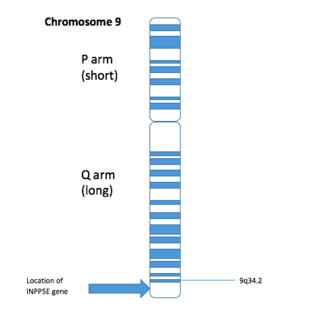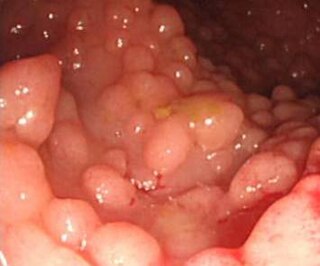
A genetic disorder is a health problem caused by one or more abnormalities in the genome. It can be caused by a mutation in a single gene (monogenic) or multiple genes (polygenic) or by a chromosomal abnormality. Although polygenic disorders are the most common, the term is mostly used when discussing disorders with a single genetic cause, either in a gene or chromosome. The mutation responsible can occur spontaneously before embryonic development, or it can be inherited from two parents who are carriers of a faulty gene or from a parent with the disorder. When the genetic disorder is inherited from one or both parents, it is also classified as a hereditary disease. Some disorders are caused by a mutation on the X chromosome and have X-linked inheritance. Very few disorders are inherited on the Y chromosome or mitochondrial DNA.
Adams–Oliver syndrome (AOS) is a rare congenital disorder characterized by defects of the scalp and cranium, transverse defects of the limbs, and mottling of the skin.

Cutis laxa or pachydermatocele is a group of rare connective tissue disorders in which the skin becomes inelastic and hangs loosely in folds.

SCARF syndrome is a rare syndrome characterized by skeletal abnormalities, cutis laxa, craniostenosis, ambiguous genitalia, psychomotor retardation, and facial abnormalities. These characteristics are what make up the acronym SCARF. It shares some features with Lenz-Majewski hyperostotic dwarfism. It is a very rare disease with an incidence rate of approximately one in a million newborns. It has been clinically described in two males who were maternal cousins, as well as a 3-month-old female. Babies affected by this syndrome tend to have very loose skin, giving them an elderly facial appearance. Possible complications include dyspnea, abdominal hernia, heart disorders, joint disorders, and dislocations of multiple joints. It is believed that this disease's inheritance is X-linked recessive.

Laminopathies are a group of rare genetic disorders caused by mutations in genes encoding proteins of the nuclear lamina. They are included in the more generic term nuclear envelopathies that was coined in 2000 for diseases associated with defects of the nuclear envelope. Since the first reports of laminopathies in the late 1990s, increased research efforts have started to uncover the vital role of nuclear envelope proteins in cell and tissue integrity in animals.

Rosselli–Gulienetti syndrome, also known as Zlotogora–Ogur syndrome and Bowen–Armstrong syndrome, is a type of congenital ectodermal dysplasia syndrome. The syndrome is relatively rare and has only been described in a few cases.

Pyrroline-5-carboxylate reductase 1, mitochondrial is an enzyme that in humans is encoded by the PYCR1 gene.

Antley–Bixler syndrome is a rare, severe autosomal recessive congenital disorder characterized by malformations and deformities affecting the majority of the skeleton and other areas of the body.

MORM syndrome is an autosomal recessive congenital disorder characterized by mental retardation, truncal obesity, retinal dystrophy, and micropenis". The disorder shares similar characteristics with Bardet–Biedl syndrome and Cohen syndrome, both of which are autosomal recessive genetic disorders. MORM syndrome can be distinguished from the above disorders because symptoms appear at a young age. The disorder is not dependent on sex of the offspring, both male and female offspring are equally likely to inherit the disorder.

Gerodermia osteodysplastica (GO) is a rare autosomal recessive connective tissue disorder included in the spectrum of cutis laxa syndromes.
Wrinkly skin syndrome(WSS) is a rare genetic condition characterized by sagging, wrinkled skin, low skin elasticity, and delayed fontanelle (soft spot) closure, along with a range of other symptoms. The disorder exhibits an autosomal recessive inheritance pattern with mutations in the ATP6V0A2 gene, leading to abnormal glycosylation events. There are only about 30 known cases of WSS as of 2010. Given its rarity and symptom overlap with other dermatological conditions, reaching an accurate diagnosis is difficult and requires specialized dermatological testing. Limited treatment options are available but long-term prognosis is variable from patient to patient, based on individual case studies. Some skin symptoms recede with increasing age, while progressive neurological advancement of the disorder causes seizures and mental deterioration later in life for some patients.

Jalili syndrome is a genetic disorder characterized by the combination of cone-rod dystrophy of the retina and amelogenesis imperfecta. It was characterized in 1988 by Dr. I. K. Jalili and Dr. N. J. D. Smith, following the examination of 29 members of an inbred Arab family living within the Gaza Strip.
Focal facial dermal dysplasia is a rare genetically heterogeneous group of disorders that are characterized by congenital bilateral scar like facial lesions, with or without associated facial anomalies. It is characterized by hairless lesions with fingerprint like puckering of the skin, especially at the temples, due to alternating bands of dermal and epidermal atrophy.
Progeroid syndromes (PS) are a group of rare genetic disorders that mimic physiological aging, making affected individuals appear to be older than they are. The term progeroid syndrome does not necessarily imply progeria, which is a specific type of progeroid syndrome.

A hereditary cancer syndrome is a genetic disorder in which inherited genetic mutations in one or more genes predispose the affected individuals to the development of cancer and may also cause early onset of these cancers. Hereditary cancer syndromes often show not only a high lifetime risk of developing cancer, but also the development of multiple independent primary tumors.
Bruno Reversade is an American human geneticist and developmental biologist. He is a Director of the Institute of Molecular and Cellular Biology and the Genome Institute of Singapore at A*STAR (Singapore) and holds several faculty positions at other universities. Reversade is known for identifying mutated genes that cause Mendelian diseases, for his research on the genetics of identical twins and for the characterizations of novel hormones.

SRD5A3-CDG is a rare, non X-linked congenital disorder of glycosylation (CDG) due to a mutation in the steroid 5 alpha reductase type 3 gene. It is one of over 150 documented types of Congenital disorders of Glycosylation. Like many other CDGs, SRD5A3 is ultra-rare, with around 38 documented cases in the world.
Nestor-Guillermo progeria syndrome is an extremely rare novel genetic disorder that is part of a group of syndromes called progeria. This disorder is characterized by the same symptoms of other progeria syndromes, which are premature aging with accompanying aged physical appearance, osteolysis, osteoporosis, scoliosis and lipoatrophy, however, what makes this disorder unique from other progeroid syndromes is the absence of any atherosclerotic, cardiovascular, and metabolic symptoms/complications, this makes the life-span of a person with NGPS somewhat longer than the average life-span of someone with progeria itself, although in place of the complications mentioned above, there's also additional symptoms, such as joint stiffness, growth retardation, facial dysmorphisms, wide cranial sutures, micrognathia, atrophic skin and a high risk of developing severe skeletal abnormalities

Waardenburg anophthalmia syndrome is a rare autosomal recessive genetic disorder which is characterized by either microphthalmia or anophthalmia, osseous synostosis, ectrodactylism, polydactylism, and syndactylism. So far, 29 cases from families in Brazil, Italy, Turkey, and Lebanon have been reported worldwide. This condition is caused by homozygous mutations in the SMOC1 gene, in chromosome 14.
Aplasia cutis-myopia syndrome is a rare genetic disorder characterized by a combination of aplasia cutis congenita, high myopia, and dysfunction of the cone-rods. Other findings include congenital nystagmus, atrophy of the iris and pigment epithelium, easily scarred skin and keratoconus. Only 4 cases have been described in medical literature. Transmission is either autosomal dominant or autosomal recessive.










